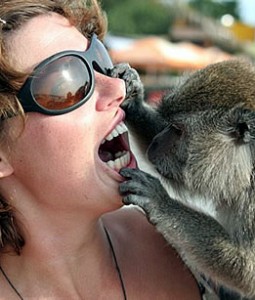
February is pet dental health month
I’m about to repeat something that your mom probably told you many times when you were growing up and it has to do with brushing teeth. But this time the advice is for your pets.
Do you brush your pet’s teeth daily?
If you’re like most pet owners, the answer is a definite NO.
You may be thinking, “My pet would never let me near his/her teeth let alone sit still while I BRUSH them” or “My life is so hectic I can barely get my own teeth brushed, let alone the cat’s.”
Most pet owners never even look in their pet’s mouths, let alone brushing their teeth.
However, being aware of the condition of your pet’s teeth and in keeping them in good shape is just as important to their health as it is to yours.
And it just so happens that February is pet dental health month, a great time to learn more on what you can do to help your pet keep his/her teeth clean.
Having your pet’s teeth checked during it’s semi-annual wellness check is normally part of your vets routine. During this check your veterinarian can help you determine your pet’s oral health state.
Periodontal disease is very common in dogs and cats and depending on its severity, it can cause varying degrees of halitosis, tartar or plaque, gingivitis and/or tooth disease depending on age and breed.
Here are step-by-step instructions (see the video below from Howzini) on how to brush your dog’s teeth:
1. Put pet-safe toothpaste on your finger and allow the dog to lick some of it off (pet toothpaste comes in flavors such as chicken).
2. Start with just 1 tooth. Put toothpaste on the toothbrush and rub in a little toothpaste where the tooth meets the gum line.
3. Do not brush your dog’s teeth like you brush your own teeth. Instead, just smear the toothpaste on your dog’s tooth — 1 tooth at a time. Dog toothpaste is made to dissolve the plaque without much rubbing or scrubbing.
4. If the first tooth went well, then try the same thing on another tooth. Until your dog gets used to this process, you may need to do only a few teeth at a time — in one sitting.
Cats can sometimes be a little trickier than dogs, and here is a video that shows a cat getting her teeth cleaned:
Here are some things you can do besides brushing to help keep your pet’s teeth clean:
- Get a professional dental cleaning to start. A routine teeth cleaning is very similar to the cleaning you receive from your hygienist.
- Provide dental treats and chews to help slow the development of tartar.
- Use veterinary approved toothpaste when you brush your pet’s teeth. Human toothpaste or baking soda can cause an upset stomach.
And just like in humans, if your pet has significant tooth or periodontal disease present, not only is his health and comfort at risk, but additional care may be necessary including tooth extractions, treatment for infections, growths and tumors.
To maintain good health, your pet needs a healthy mouth. Daily brushing can help and you can contact your veterinarian for recommendations on how you can prevent and/or treat dental disease in your pet.
As always, if you are looking for veterinary care, VetLocator.com has local vets that are available to provide the help that you need and if you can’t find what you are looking for, just shoot our Customer Care staff an email and we’ll be glad to help you out!
Here’s to great teeth for both you and your pets,
![]()
www.vetlocator.com
Tags: cat dental instructions, Pet Dental Care, Pet dental instructions